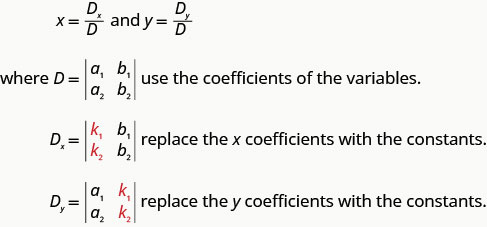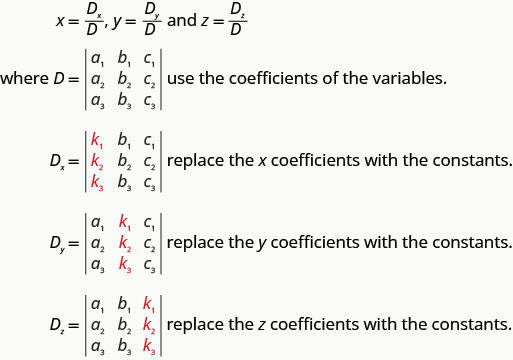Solving Systems With Infinitely Many Solutions
Systems of Linear Equations
Solve Systems of Equations Using Determinants
Learning Objectives
By the end of this section, you will be able to:
Before you get started, take this readiness quiz.
- Simplify:

If you missed this problem, review (Figure).
- Simplify:

If you missed this problem, review (Figure).
- Simplify:

If you missed this problem, review (Figure).
In this section we will learn of another method to solve systems of linear equations called Cramer's rule. Before we can begin to use the rule, we need to learn some new definitions and notation.
Evaluate the Determinant of a  Matrix
Matrix
If a matrix has the same number of rows and columns, we call it a square matrix. Each square matrix has a real number associated with it called its determinant. To find the determinant of the square matrix ![]() we first write it as
we first write it as ![]() To get the real number value of the determinate we subtract the products of the diagonals, as shown.
To get the real number value of the determinate we subtract the products of the diagonals, as shown.

Determinant
The determinant of any square matrix ![]() where a, b, c, and d are real numbers, is
where a, b, c, and d are real numbers, is
![]()
Evaluate the determinate of ⓐ ![]() ⓑ
ⓑ ![]()
Evaluate the determinate of ⓐ ![]() ⓑ
ⓑ ![]()
ⓐ ![]() ⓑ
ⓑ ![]()
Evaluate the determinate of ⓐ ![]() ⓑ
ⓑ ![]()
ⓐ 2 ⓑ ![]()
Evaluate the Determinant of a  Matrix
Matrix
To evaluate the determinant of a ![]() matrix, we have to be able to evaluate the minor of an entry in the determinant. The minor of an entry is the
matrix, we have to be able to evaluate the minor of an entry in the determinant. The minor of an entry is the ![]() determinant found by eliminating the row and column in the
determinant found by eliminating the row and column in the ![]() determinant that contains the entry.
determinant that contains the entry.
Minor of an entry in ![]() a Determinant
a Determinant
The minor of an entry in a ![]() determinant is the
determinant is the ![]() determinant found by eliminating the row and column in the
determinant found by eliminating the row and column in the ![]() determinant that contains the entry.
determinant that contains the entry.
To find the minor of entry ![]() we eliminate the row and column which contain it. So we eliminate the first row and first column. Then we write the
we eliminate the row and column which contain it. So we eliminate the first row and first column. Then we write the ![]() determinant that remains.
determinant that remains.

To find the minor of entry ![]() we eliminate the row and column that contain it. So we eliminate the 2nd row and 2nd column. Then we write the
we eliminate the row and column that contain it. So we eliminate the 2nd row and 2nd column. Then we write the ![]() determinant that remains.
determinant that remains.

For the determinant  find and then evaluate the minor of ⓐ
find and then evaluate the minor of ⓐ ![]() ⓑ
ⓑ ![]() ⓒ
ⓒ ![]()
ⓐ 3 ⓑ 11 ⓒ 2
We are now ready to evaluate a ![]() determinant. To do this we expand by minors, which allows us to evaluate the
determinant. To do this we expand by minors, which allows us to evaluate the ![]() determinant using
determinant using ![]() determinants—which we already know how to evaluate!
determinants—which we already know how to evaluate!
To evaluate a ![]() determinant by expanding by minors along the first row, we use the following pattern:
determinant by expanding by minors along the first row, we use the following pattern:

Remember, to find the minor of an entry we eliminate the row and column that contains the entry.
Expanding by Minors along the First Row to Evaluate a ![]() Determinant
Determinant
To evaluate a ![]() determinant by expanding by minors along the first row, the following pattern:
determinant by expanding by minors along the first row, the following pattern:

Evaluate the determinant  by expanding by minors along the first row.
by expanding by minors along the first row.
Evaluate the determinant  by expanding by minors along the first row.
by expanding by minors along the first row.
37
Evaluate the determinant  by expanding by minors along the first row.
by expanding by minors along the first row.
7
To evaluate a ![]() determinant we can expand by minors using any row or column. Choosing a row or column other than the first row sometimes makes the work easier.
determinant we can expand by minors using any row or column. Choosing a row or column other than the first row sometimes makes the work easier.
When we expand by any row or column, we must be careful about the sign of the terms in the expansion. To determine the sign of the terms, we use the following sign pattern chart.

Sign Pattern
When expanding by minors using a row or column, the sign of the terms in the expansion follow the following pattern.

Notice that the sign pattern in the first row matches the signs between the terms in the expansion by the first row.

Since we can expand by any row or column, how do we decide which row or column to use? Usually we try to pick a row or column that will make our calculation easier. If the determinant contains a 0, using the row or column that contains the 0 will make the calculations easier.
Evaluate the determinant  by expanding by minors.
by expanding by minors.
Evaluate the determinant  by expanding by minors.
by expanding by minors.
![]()
Evaluate the determinant  by expanding by minors.
by expanding by minors.
8
Use Cramer's Rule to Solve Systems of Equations
Cramer's Rule is a method of solving systems of equations using determinants. It can be derived by solving the general form of the systems of equations by elimination. Here we will demonstrate the rule for both systems of two equations with two variables and for systems of three equations with three variables.
Let's start with the systems of two equations with two variables.
Cramer's Rule for Solving a System of Two Equations
For the system of equations ![]() the solution
the solution ![]() can be determined by
can be determined by

Notice that to form the determinant D, we use take the coefficients of the variables.

Notice that to form the determinant ![]() and
and ![]() we substitute the constants for the coefficients of the variable we are finding.
we substitute the constants for the coefficients of the variable we are finding.

How to Solve a System of Equations Using Cramer's Rule
Solve using Cramer's rule: ![]()
![]()
Solve using Cramer's rule: ![]()
![]()
To solve a system of three equations with three variables with Cramer's Rule, we basically do what we did for a system of two equations. However, we now have to solve for three variables to get the solution. The determinants are also going to be ![]() which will make our work more interesting!
which will make our work more interesting!
Cramer's Rule for Solving a System of Three Equations
For the system of equations  the solution
the solution ![]() can be determined by
can be determined by

Solve the system of equations using Cramer's Rule: 
Solve the system of equations using Cramer's Rule: 
![]()
Solve the system of equations using Cramer's Rule: 
![]()
Cramer's rule does not work when the value of the D determinant is 0, as this would mean we would be dividing by 0. But when ![]() the system is either inconsistent or dependent.
the system is either inconsistent or dependent.
When the value of ![]() and
and ![]() and
and ![]() are all zero, the system is consistent and dependent and there are infinitely many solutions.
are all zero, the system is consistent and dependent and there are infinitely many solutions.
When the value of ![]() and
and ![]() and
and ![]() are not all zero, the system is inconsistent and there is no solution.
are not all zero, the system is inconsistent and there is no solution.
Dependent and Inconsistent Systems of Equations
For any system of equations, where the value of the determinant ![]()

In the next example, we will use the values of the determinants to find the solution of the system.
Solve the system of equations using Cramer's rule : ![]()

We cannot use Cramer's Rule to solve this system. But by looking at the value of the determinants ![]() and
and ![]() we can determine whether the system is dependent or inconsistent.
we can determine whether the system is dependent or inconsistent.

Since all the determinants are not zero, the system is inconsistent. There is no solution.
Solve the system of equations using Cramer's rule: ![]()
no solution
Solve the system of equations using Cramer's rule: ![]()
infinite solutions
Solve Applications using Determinants
An interesting application of determinants allows us to test if points are collinear. Three points ![]()
![]() and
and ![]() are collinear if and only if the determinant below is zero.
are collinear if and only if the determinant below is zero.

Test for Collinear Points
Three points ![]()
![]() and
and ![]() are collinear if and only if
are collinear if and only if

We will use this property in the next example.
Determine whether the points ![]()
![]() and
and ![]() are collinear.
are collinear.
 | |
| Substitute the values into the determinant. |  |
| Evaluate the determinant by expanding by minors using column 3. |  |
| Evaluate the determinants. |  |
| Simplify. |  |
| Simplify. |  |
| The value of the determinate is 0, so the points are collinear. |
Determine whether the points ![]()
![]() and
and ![]() are collinear.
are collinear.
yes
Determine whether the points ![]()
![]() and
and ![]() are collinear.
are collinear.
yes
Key Concepts
Practice Makes Perfect
Evaluate the Determinant of a 2 × 2 Matrix
In the following exercises, evaluate the determinate of each square matrix.
![]()
![]()
4
![]()
![]()
10
Evaluate the Determinant of a 3 × 3 Matrix
In the following exercises, find and then evaluate the indicated minors.
ⓐ 6 ⓑ ![]() ⓒ
ⓒ ![]()
ⓐ 9 ⓑ ![]() ⓒ 8
ⓒ 8
In the following exercises, evaluate each determinant by expanding by minors along the first row.


![]()


49
In the following exercises, evaluate each determinant by expanding by minors.


![]()


25
Use Cramer's Rule to Solve Systems of Equations
In the following exercises, solve each system of equations using Cramer's Rule.
![]()
![]()
![]()
![]()
![]()
![]()
![]()
![]()
![]()
![]()
![]()
![]()


![]()


![]()


![]()


![]()
![]()
![]()
infinitely many solutions
![]()
![]()
inconsistent


inconsistent


infinitely many solutions
Solve Applications Using Determinants
In the following exercises, determine whether the given points are collinear.
Writing Exercises
Explain the difference between a square matrix and its determinant. Give an example of each.
Explain what is meant by the minor of an entry in a square matrix.
Answers will vary.
Explain how to decide which row or column you will use to expand a ![]() determinant.
determinant.
Explain the steps for solving a system of equations using Cramer's rule.
Answers will vary.
Self Check
ⓐ After completing the exercises, use this checklist to evaluate your mastery of the objectives of this section.

ⓑ After reviewing this checklist, what will you do to become confident for all objectives?
Solving Systems With Infinitely Many Solutions
Source: https://pressbooks.bccampus.ca/algebraintermediate/chapter/solve-systems-of-equations-using-determinants/